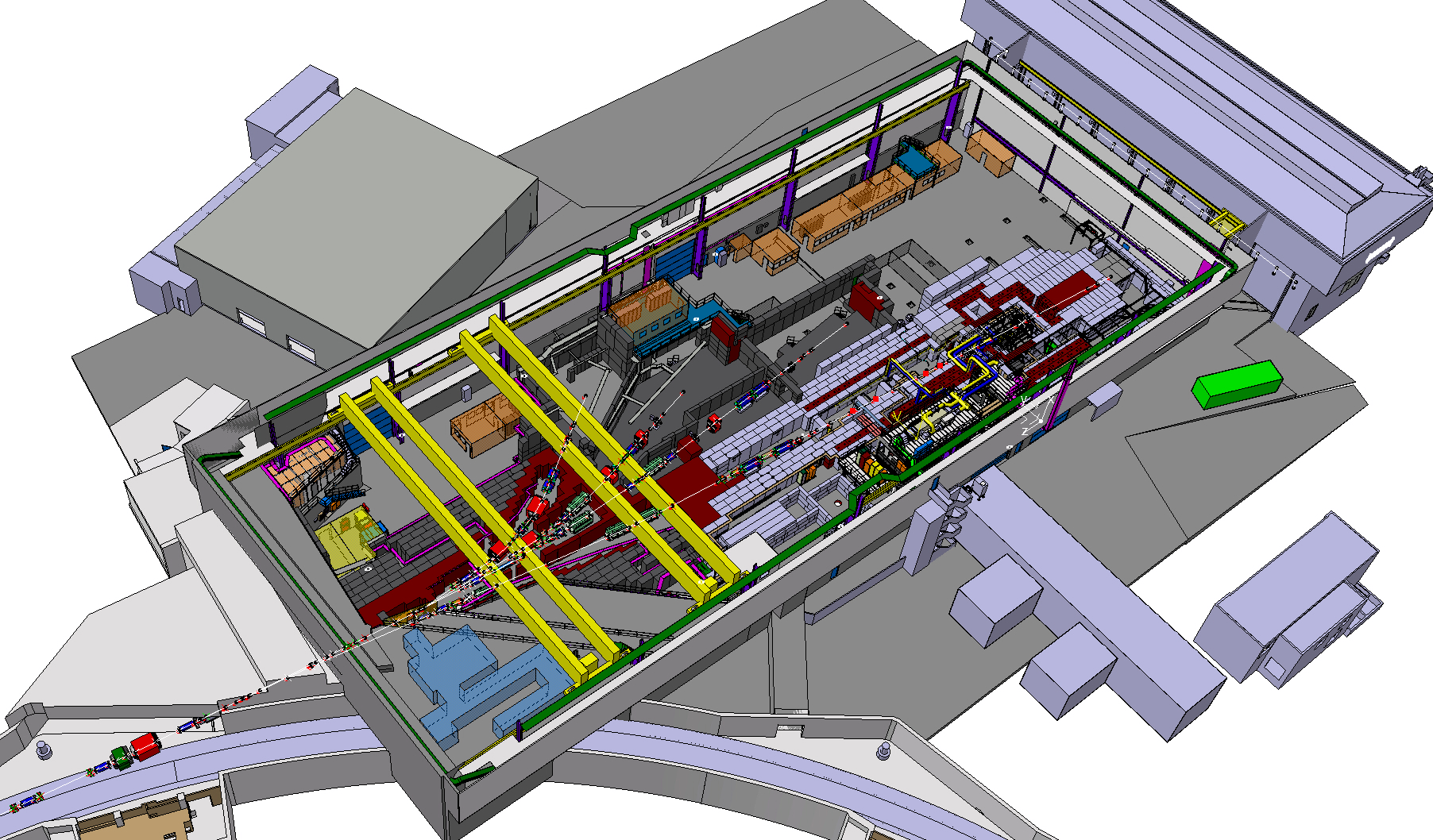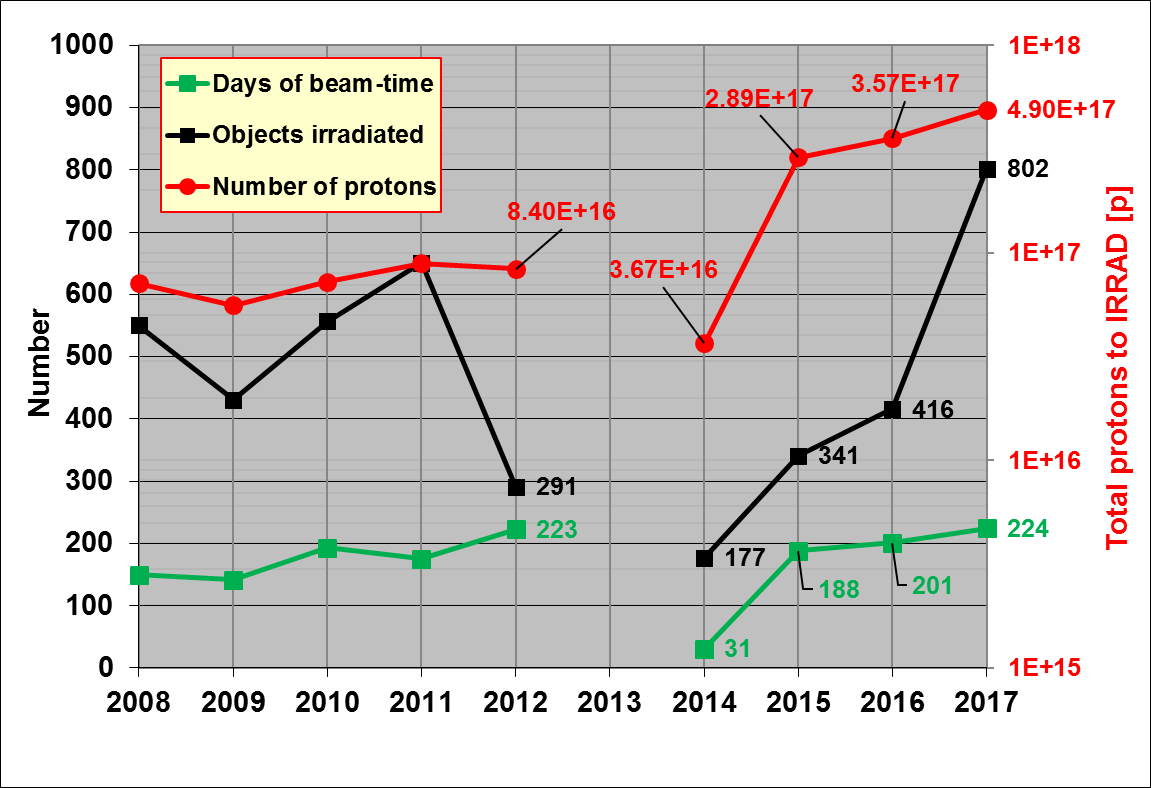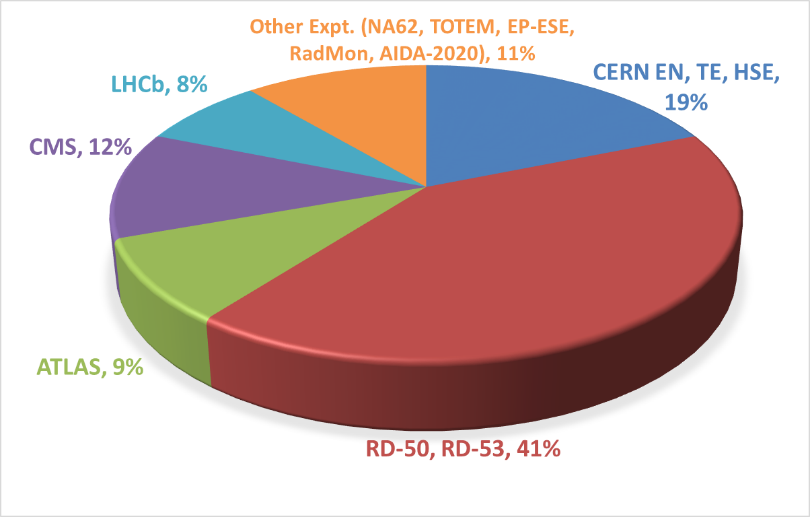An exceptional year for the EP-DT proton irradiation facility IRRAD
The CERN proton irradiation facility (IRRAD) at the PS East Area has been designed and built during LS1 to cope with the increasing need for irradiation experiments of the EP experimental community, working for the High-Luminosity upgrade of the LHC and beyond. This new facility is the natural upgrade of a historical service in the experimental physic department that, since the early 90’s, exploit the high intensity proton beam of the CERN PS for studying the radiation hardness of materials and semiconductor devices (see also: https://ep-news.web.cern.ch/content/new-proton-mixed-field-irradiation-facility-cern-ps-1).

The IRRAD facility, operated by the PH-DT group, is nowadays part of a more complex infrastructure in the PS East Area available after the LS1. The new PS facility is divided in two separated irradiation areas operating in parallel and sharing the same high-energy proton beam (24 GeV/c) extracted from the PS to the T8 beam-line. The IRRAD facility is located upstream of the mixed-field facility (CHARM). While in IRRAD, irradiation experiments are performed with the primary protons, in CHARM a mixed-particle radiation field is used after being generated by a 50 cm thick copper or aluminium target. The CHARM facility, operated by the EN department, is optimized to reproduce the radiation environment of the LHC tunnel and the typical shielded areas of the CERN accelerator complex. Moreover, since 2016, the East Area facility hosts also a measurement location which makes parasitic use of the radiation field emerging from the CHARM target to perform characterization studies of the shielding properties of various materials. This facility (called CERN Shielding Benchmark Facility or CSFB) is used by the CERN Radiation Protection group and benefits of one week of dedicated beam-time per year.
After a short run of one month in 2014, IRRAD has been operational for three full consecutive years since 2015. In a calendar year, about 200 days of beam-time are available for irradiation experiments in IRRAD. As shown in Figure 1, the number of irradiated samples constantly increased year after year since the new facility begun its operation after LS1. More in detail, the run 2017 for the users of IRRAD started at the end of April and ended on 3rd of December 2017. During these 32-weeks of operation, more than 800 objects, belonging to 33 users of 19 different institutes from 12 countries, have been exposed to the proton beam. This large number of samples (about 50% more than in the previous run 2016) represents a record for the new facility. This exceptional performance was possible also thanks to the excellent availability of the PS accelerator and the high-quality of the irradiation beam provided by the BE-OP team at the CCC which nowadays steadily approach the design limit of 5x1011 particles per proton spill delivered to IRRAD.

Fig.1 – Statistics for the IRRAD facility before and after LS1 (2012-2014). The number of irradiated objects and days of beam time (left vertical axis), as well as the total number of protons delivered to IRRAD (right vertical axis), are plotted for the last 9-years of operation.
Details on the users of the facility and the number of irradiated objects per experiment, for the year 2017, are given in Figure 2. About 40% of them are solid-state detector test-samples belonging to the R&D collaborations, mainly RD50 (www.cern.ch/rd50) for which the IRRAD facility was originally developed in the late 90’s. Another 40% of samples comes for the LHC and other CERN experimental collaborations such NA62. This includes the ATLAS, CMS, LHCb and TOTEM experiments that are now evaluating the new detector technologies for the Phase II and future upgrades of their tracking and calorimeter detectors, as well as samples from common development projects performed within the CERN microelectronics group (EP-ESE) and R&D projects for future accelerators (FCC). The final 20% is constituted of material samples for radiation hardness studies belonging to LHC equipment groups in the EN and TE department (electrical distribution, magnets, etc.) as well as to the CERN safety unit (HSE).

Fig.2 –Origin of the objects (more than 800 in total) exposed to the proton beam in IRRAD during 2017.
Although the proton run is now concluded, before the YETS 2017/2018, the first two weeks of December 2017 are now dedicated to the development and commissioning of a heavy-ions beam on T8. This has the main goal to provide a beam for Single Event Effect (SEE) studies in electronic components for space application in CHARM; however, it will be made available in the end of 2018 (with Pb-ions) also to the users of IRRAD.
The IRRAD team in EP-DT is looking forward to the irradiation run 2018, the last one before the LS2. The detailed program for 2018, as well as all information about how to request beam-time and register samples for proton irradiation will become available at this URL: www.cern.ch/ps-irrad during February next year. So far, users from ATLAS, CMS, the CERN vacuum group (TE) and target group (STI) express their interest and requested beam-time in IRRAD, confirming the key role of this test infrastructure for the CERN experimental and accelerator communities.
The IRRAD facility is also part of the AIDA2020 Transnational Access to irradiation facilities program that provides funding for external users to perform their irradiation tests at CERN. More details are available here: http://aida2020.web.cern.ch/content/how-apply-transnational-access
The EP-DT Irradiation Facilities team: B. Gkotse, M. Glaser, G. Gorine, M. Jaekel, I. Mateu, G. Pezzullo and F. Ravotti
